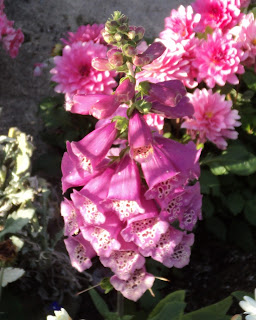Source
Materials is my new label for
posts about things from outside
Disney theme parks that influence decisions about what to include
inside
the parks. For instance, I have retroactively re-classified my
two-part post about heraldry in Fantasyland as a Source Materials
post. There probably won't be too many of these; most of the stuff
that would qualify has been gone over, extensively and in more depth
than I think I would muster, by other bloggers. (Check out the
sidebar for some of them!)
It's
June now. What can I write about that goes well with June?
Gardening?
Did I hear gardening? Gardening it is. It turns out to be a fertile*
subject where Disneyland is concerned. The park's Horticulture
Department is quite the unsung hero, producing magnificent work
pretty much across the board, from the obvious:
to
the subtle:
People
certainly notice the lovely
trees and garden beds throughout Disneyland, but only rarely is
attention deliberately drawn toward them. It's even rarer that the
specific choices made by the Horticulture Department get any focus,
even though they're often brilliantly on-the-nose. Magnolia trees in
New Orleans Square and edelweiss around the base of the Matterhorn
are just the tip of the iceberg (lettuce).** In many cases, the
appropriateness is more than just geographic.
Here
are a few of my favorites.
Storybook
Land Canal Boats
This
is one of the few places where the Cast Members do call attention to
the landscaping, although they usually eschew species identification
in favor of references to pixie dust. One exception is these lovely
arches, whose roses are pointed out in the script:
Supposedly
these are the same arches Aladdin and Princess Jasmine flew
underneath during their magic carpet ride. But what are those
white-flowered bushes at the base, along the canal's edge?
Unfortunately I couldn't find (or take) any really good close-ups, but you can still spot the telltale star
shape of the blossoms.
It's
jasmine.
When
it's in full bloom, as in the upper photo, the fragrance is
extraordinary.
That's
a straightforward allusion. Sometimes, instead, they go for something
symbolic...
Haunted
Mansion
The
queue area of the Haunted Mansion in general constitutes some of the
best horticultural work in the park, with its impeccably manicured
lawn and plants with dark or drooping foliage that creates an
ever-so-slight sense of the macabre:
More
subtle are these tall, sculpted trees behind the Mansion:
These
are Italian cypresses—a very popular tree for decoration and
privacy hedges due to how well it responds to being pruned like this.
Their dark needles perfectly offset the stark near-whiteness of the
Mansion itself, giving the building a backdrop of somber elegance.
Also,
cypresses symbolize death.
In
ancient Egypt, the wood was used for making coffins because it was
believed impervious to rot. The name of the tree comes from the
mythical character Cyparissus, who was so remorseful after killing a
favorite stag that he asked the gods for eternal life so he could
mourn the animal forever; in response, Apollo transformed him into a
cypress tree. Cypresses are planted in many European graveyards due
to this association.
Not
bad for something you thought was there just because it looked nice.
Pixie
Hollow
The
flower beds outside Pixie Hollow are a marvel of organized chaos.
Here are just a few photos:
I
have no idea what all of these are called, though I really like the
white ones with a magenta ring around the center. Rosetta and her
guild have been hard at work, I assume we are meant to think. But
allow me to point out something special:
That,
of course, is foxglove, the source of the heart medication known as
digoxin or digitalis (which is also the generic name of the plant).
It's not often that such a pretty plant is also so medically useful.
Healthcare applications aside, this is a superbly appropriate flower
to have planted near Pixie Hollow, because according to folklore, it
is one of the flowers especially beloved by fairies. In fact the name
has nothing to do with foxes, but is a corruption of folk's
glove, as in the Little Folk.
If
it were up to me, these beds would also feature hollyhocks,
marigolds, and wild thyme,*** but we can't have everything.
Snow
White's Scary Adventures
Sometimes,
Disneyland's horticulturists are just plain witty.
Take a look at this small tree growing in a planter outside Snow
White's Scary Adventures:
Can
you guess what kind of tree it is?
You
guessed “apple,” didn't you? You would be correct. But it gets
better. Here's a close-up of the same tree in the fall, when its
easy-to-guess fruit is ripening:
Those
apples look pretty small, don't they? They're noticeably smaller than
the leaves, at any rate, which is highly atypical. You might even say
they're...
...wait
for it...
...dwarf
apples.
Okay,
I think we can stop there for now. Hopefully I've inspired you to
take a closer look at the landscaping the next time you're at
Disneyland. You never know when you might spot something that's just
so astonishingly fitting.
* Pun goblin snuck up on
me.
** There it is again!
*** These are some of the
ingredients in a medieval recipe for a potion that lets you see
fairies. Supposedly. I've never tried it myself.














No comments:
Post a Comment